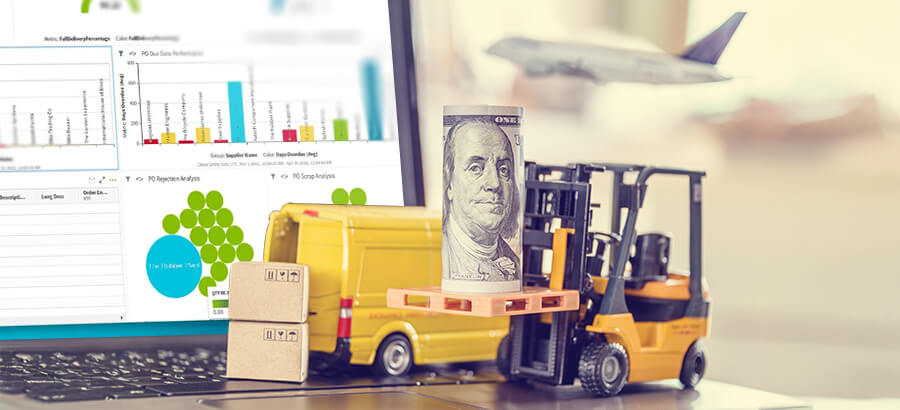Supply chain disruptions are nothing new. From global trade disputes to Brexit, volatile exchange rates, fluctuating commodity prices and civil unrest, procurement has needed to be more agile and resilient than ever before. Recently COVID-19 added further pressure within the global value chain. China is a large producer of components and assemblies, but with the recent pandemic, many of these distribution channels were shut down with no notification and very little time to replace suppliers.
As a means of proactive response, businesses should look at a four-step strategy to build procurement resilience in the wake of global vulnerabilities.
Step 1: Anticipate and plan for uncertainty
By making a direct link between supply and demand, manufacturers and distributors can anticipate and better plan for uncertainty. Today, the rigorous process of gathering as well as interpreting supplier, market, and environmental information is being replaced with a data-driven approach. This enables real-time decision-making with businesses building AI-driven integrated data ecosystems that are underpinned by predictive analytics. Resultant insights can then be applied in forward planning on both strategy and performance.
In addition to outsourcing solutions to understand the changing needs of the macro environment, manufacturers and distributors can use technologies such as Enterprise Resource Planning to accurately forecast demand, identify stock availability, establish supplier lead times, cost, material requirements, contingency stock requirements, and warehouse capacity constraints, and integrate this all into their unique business model.
This will ultimately improve the cash flow of the organization because procurement teams can better determine purchasing requirements based upon demand, and hedge against the obsolesce and waste of critical raw materials stock.
Step 2: Embrace the limitless potential of digitalization
With the pandemic and global lockdowns, many manufacturers began to realize the true potential of digital transformation. Digitalization can assist strategic sourcing to become more predictive, transactional procurement more automated, and supplier relationship management more proactive. Digital procurement solutions are enabling the future by providing access to previously unavailable insights or bringing order to massive (but unstructured) data sets, ultimately driving more complex analysis and better supplier strategies; enabling more efficient operations.
Step 3: Enable end-to-end supply chain visibility
World crises have resulted in procurement teams scrambling for alternative and locally based suppliers to ensure that they can still fulfill existing orders and continue to produce with new orders. End-to-end supply chain visibility is therefore a necessity to ensure procurement accuracy and resilience. This is needed to provide a single platform where everything from early-stage planning based on forecasts through Master Production Schedules (MPS) to final delivery can be tracked and traced in real-time on a global scale. These advanced insights are needed to improve customer service, reduce costs, help with regulatory directives, and mitigate interruptions that will affect supplier inventory levels and ultimately product delivery. With customers demanding better service, embedded AI capabilities provide real-time intelligence, actionable insights, and recommendations that reduce disruption time from days to hours, improving customer service in line with expectations.
Supply chain visibility adds many other advantages for today’s global businesses. It allows them to reduce complexity, improve communication throughout the organization, remain nimble, and keep up with a changing and complex regulatory landscape.
Step 4: Focus on building a robust procurement model
There are no standard business models to help businesses to manage what we are currently facing. This pandemic has exposed the fragility and the thin margins on which many global businesses run. Highly indebted companies, working from lean inventory, supported by just-in-time supply chains, and staffed by short-term contractors are suffering the longer-term impact of market unpredictability. Companies have realized that by encouraging their procurement departments to pursue the holy grail of greater efficiency through wholesale cost-cutting, have sacrificed robustness, resilience, and effectiveness. In many cases, it has turned out they have sacrificed the business itself.
Manufacturers and distributors need to identify their own business model that will suit their own business. Copying competitors is no longer viable. They will also have to consider how to reengineer their supply chains to be resilient by design, factoring in increased complexity and uncertainty as the new normal. In the months and years ahead, effective supply chain management will be all about agility and finding the perfect balance between just-in-time processes and just-in-case scenarios while reducing risk as much as possible.
The ERP Advantage
Enterprise Resource Planning (ERP) can help procurement to remain resilient in several ways. First and foremost, an ERP brings a single integrated platform that shares all of the information across all functions. This integration allows manufacturers to optimize inventory forecasting capabilities to improve management of purchasing requirements, while alternative potential suppliers can be identified through supplier portals, and invitations using a Request For Information or even a Request For Quote can be shared with suppliers. Bearing in mind that the ongoing procurement of raw materials can quickly consume all of the cash reserves of the organization and needs to be agreed by the organizational leadership if it places the organization in any risk. The integrated nature of an ERP system allows everyone to have the full picture which improves the quality of the decision making within the organization.
Global crises are an inevitable factor of life. By planning for the unknown, implementing the right technology for end-to-end supplier visibility, and building a robust procurement model, manufacturers and distributors can ensure procurement resilience in a VUCA world.







